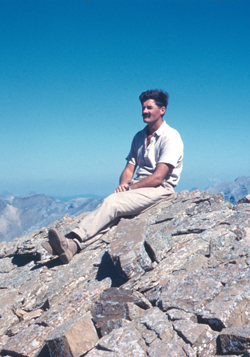Carbonate and petroleum exploration specialist who advanced research into modern dolomite formation

Alan James Wells pursued a lifetime career of research with Royal Dutch Shell and its associated companies in several countries, culminating with the position of Head of geological research at the Shell International Exploration and Production Laboratory in The Hague from 1978 to 1981.
After leaving school in 1944, Alan spent three years with the Royal Air Force including a posting to Ceylon (now Sri Lanka). After graduating from King’s College, Cambridge, he returned to Ceylon in 1952 to research the source of corundum, locating gem-quality sapphires in igneous intrusions high in the mountains (
Geological Magazine, 1956). He followed this with PhD research in Yorkshire under Professor Kingsley Dunham of Durham University.
Left: Alan James Wells. Image courtesy of Caroline Wells.
Dolomite discovery
During his career with Shell in The Hague, Alan’s fieldwork in the 1950s included: mapping the geology of southern Libya; a rugged season observing exposed Upper Devonian reef complexes in Western Australia; and two seasons of fieldwork on horseback in the Rocky Mountains, Canada.
Alan then studied carbonate formation processes in Qatar in sabkhas, semi-enclosed bays in the intertidal zone where sediments accumulate due to repeated wetting and drying of the area. He recognised that the mineral dolomite, a double carbonate of calcium and magnesium, was being formed in the evaporitic environment of the sabkhas, publishing that important discovery in
Nature in 1962.
Petroleum exploration
During a research period back at Shell’s laboratory in The Hague, Alan organised carbonate seminars and field excursions to Belgium and Yorkshire and compiled a geological history of oil exploration areas in the Middle East. Between 1964 and 1968, as Senior Geologist of the Iranian Oil operating companies, he led fieldwork along the Zagros mountains to evaluate oil-bearing potential amongst the limestone rock formations in southwestern Iran. Here, an important discovery was made unrelated to oil prospecting. Whilst working east of Shiraz in 1967, Alan identified the exact crush zone between two tectonic plates, mapping the impact zone extending along the Zagros range (
Geological Magazine, 1969).
Further overseas postings saw Alan as Exploration Manager in Turkey, then Exploration Manager of Petroleum Development (Oman), before his appointment as Head of research for Shell International in The Hague.
After 1981, his final working years were as a consultant for Shell Canada where he investigated the Atlantic coastline and offshore area. Alan was held in high regard by his colleagues worldwide, with particular recognition for his outstanding fieldwork skills. His three key geological discoveries relating to dolomite, corundum, and the Zagros crush zone are widely acknowledged.
Rewarding life
Alan lived a full and rewarding life in other respects. He and his beloved wife Yvonne (1927-2022) loved the opportunities for exploration and experiencing other cultures that his career gave them. They travelled adventurously by campervan over all terrains. His interests included flying, photography, music, and occasionally driving steam trains. Alan died aged 97 on 31st March 2024. He is survived by his daughter Alison Kitchen, his son James Wells, two grandchildren, and three great-grandchildren.
By Caroline Wells